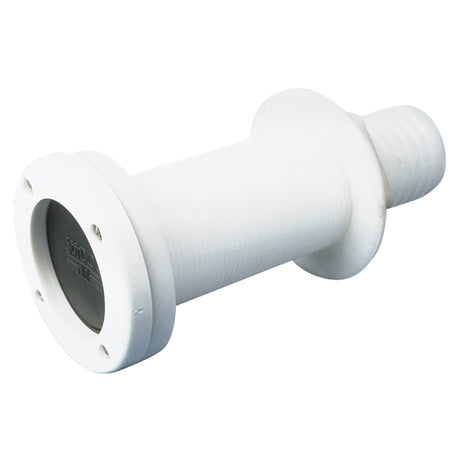Today, we set sail into the intricate universe of boat accessories, with a special focus on the indispensable components known as thru-hull fittings. Picture your vessel as a well-oiled machine, and these fittings as the silent heroes below the waterline, ensuring a smooth and safe journey. From stainless steel to bronze and plastic, we'll unravel the secrets of choosing the right materials for your marine companion. Get ready for a deep dive into the nuances of 90-degree angles, livewell fittings, and the art of installation. Whether you're a seasoned sailor or just dipping your toes into the marine world, this guide is your compass to mastering thru-hull fittings.
Setting Sail with Thru-Hull Fittings
Welcome aboard the exploration of thru-hull fittings—a critical element for any boat. These fittings, often referred to simply as 'thru-hulls,' play a vital role in maintaining the integrity of your vessel. They are the connectors that create a watertight seal between the inside and outside of your boat, ensuring a safe and enjoyable time on the water.
Choosing the Right Material: Stainless Steel, Bronze, or Plastic?
Thru-hull fittings come in various materials, each with its unique set of advantages. Stainless steel, known for its durability, resists corrosion even in harsh marine environments. Bronze, a classic choice, combines strength with a timeless aesthetic. Meanwhile, plastic thru-hull fittings, often made of polypropylene, provide a lightweight and cost-effective option.
When outfitting your boat, consider the type of water you'll be navigating and the specific needs of your vessel. Stainless steel may be the go-to for saltwater adventures, while bronze exudes elegance in freshwater settings. Plastic fittings, on the other hand, are lauded for their versatility and affordability.
Exploring Different Types of Thru-Hull Fittings
- 90-Degree Thru-Hull Fittings: Perfect for tight spaces, these fittings make efficient use of limited hull real estate, ensuring your boat remains sleek and streamlined.
- Livewell Thru-Hull Fitting: For anglers and fishing enthusiasts, this specialized fitting facilitates the flow of water into livewells, maintaining a healthy environment for your catch.
Sizing Matters: 1 3/4, 1 Inch, 3/4, and More
Determining the right size for your thru-hull fitting is crucial. The measurements, such as 1 3/4 inches, 1 inch, and 3/4 inches, indicate the diameter of the fitting. Ensuring a snug fit is essential to prevent leaks and maintain the structural integrity of your boat.
Below Waterline Thru-Hull Fittings: Ensuring Safety
Thru-hull fittings positioned below the waterline demand extra attention. Their installation must be precise, and regular checks are imperative to prevent any compromise in the vessel's watertight integrity. Always adhere to best practices and, when in doubt, consult a marine professional.
Installation Wisdom: A Nut and Bolt Approach
Installing thru-hull fittings is a task that demands precision. Begin by choosing the right location on the hull, ensuring it doesn't interfere with the boat's structure. Secure the fitting with a nut on the inside and a flange on the outside, creating a robust connection. Applying marine sealant is the final step to guarantee a watertight seal.
Diverse Options: Brass, Stainless, and More
Beyond stainless steel and bronze, brass and other alloys offer additional options for thru-hull fittings. Each material brings its own set of characteristics, from corrosion resistance to aesthetic appeal. Consider the specific demands of your boating lifestyle to make the optimal choice.
Frequently Asked Questions (FAQs) About Thru-Hull Fittings
For the uninitiated, thru-hull fittings can be a mystery. In simple terms, they are connectors that penetrate the boat's hull, providing a passage for water or other fluids. These fittings are essential for various systems on board, including plumbing, cooling, and drainage.
Q1: Why are thru-hull fittings important?
A2: Thru-hull fittings are crucial for maintaining the structural integrity of a boat. They facilitate water flow, drainage, and are integral to systems like plumbing and cooling.
Q2: What materials are commonly used for thru-hull fittings?
Stainless steel, bronze, and plastic (polypropylene) are common materials. Each offers unique advantages, such as durability, corrosion resistance, and cost-effectiveness.
Q3: How do I choose the right thru-hull fitting size?
Measure the diameter of the hole needed for the fitting. Sizes like 1 3/4 inches, 1 inch, and 3/4 inches indicate the diameter, ensuring a proper fit to prevent leaks.
Q4: Are there specific thru-hull fittings for certain spaces?
Yes, 90-degree thru-hull fittings are ideal for tight spaces, ensuring efficient use of hull real estate. Livewell thru-hull fittings are specialized for maintaining a healthy environment for caught fish.
Q5: What precautions should be taken with below waterline thru-hull fittings?
Thru-hull fittings below the waterline require precise installation and regular checks to ensure watertight integrity. Consult with a marine professional for guidance.
Q6: How do I install a thru-hull fitting?
Choose the right location, secure with a nut on the inside and a flange on the outside, and use marine sealant for a watertight seal. Seek professional guidance if unsure.
Q7: Can I use different materials for thru-hull fittings?
A8: Yes, options include brass, stainless steel, and other alloys. Consider the specific characteristics of each material based on your boating needs.
Q8: What are the benefits of 90-degree thru-hull fittings?
90-degree fittings are space-efficient, making them ideal for tight areas. They contribute to maintaining the sleek and streamlined appearance of your boat.
Q9: How often should I check and maintain my thru-hull fittings?
Regular checks are crucial, especially for fittings below the waterline. Perform maintenance as needed, and be proactive to prevent potential issues during your boating adventures.
Navigating with Confidence
As we conclude our voyage through the world of thru-hull fittings, remember that these seemingly small components play a colossal role in the overall functionality and safety of your boat. Whether you opt for the robustness of stainless steel, the timeless charm of bronze, or the versatility of plastic, each material has its place in the maritime tapestry.
Mastering the installation and maintenance of thru-hull fittings ensures that your seafaring adventures remain smooth and worry-free. As you sail into the vastness of marine experiences, may your thru-hull fittings stand as reliable guardians beneath the waterline, ready for whatever tides may come.

















![GROCO 2" Bronze High Speed Thru-Hull Fitting w/Nut [HSTH-2000-W]](http://www.boaterstop.com/cdn/shop/files/75380XL.jpg?v=1686456412&width=460)
![GROCO 2" Bronze Combo Scoop Thru-Hull w/Nut [STH-2000-W]](http://www.boaterstop.com/cdn/shop/files/75334XL.jpg?v=1686456079&width=460)
![GROCO 1-1/2" Bronze Combo Scoop Thru-Hull w/Nut [STH-1500-W]](http://www.boaterstop.com/cdn/shop/files/75333XL.jpg?v=1686456070&width=460)
![GROCO 1" Bronze Combo Scoop Thru-Hull w/Nut [STH-1000-W]](http://www.boaterstop.com/cdn/shop/files/75331XL.jpg?v=1686456054&width=460)
![GROCO Stainless Steel Hose Barb Thru-Hull Fitting - 1" [HTH-1000-S]](http://www.boaterstop.com/cdn/shop/files/75225XL.jpg?v=1686455417&width=460)
![GROCO Bronze Hose Barb Thru-Hull Fitting - 2" [HTH-2000]](http://www.boaterstop.com/cdn/shop/files/75221XL.jpg?v=1686455384&width=460)
![GROCO 2" NPS NPT Combo Stainless Steel Thru-Hull Fitting w/Nut [TH-2000-WS]](http://www.boaterstop.com/cdn/shop/files/74304XL.jpg?v=1686451707&width=460)
![GROCO 2" NPS NPT Combo Bronze Thru-Hull Fitting w/Nut [TH-2000-W]](http://www.boaterstop.com/cdn/shop/files/74298XL.jpg?v=1686451659&width=460)
![GROCO 1-1/2" NPS NPT Combo Bronze Thru-Hull Fitting w/Nut [TH-1500-W]](http://www.boaterstop.com/cdn/shop/files/74293XL.jpg?v=1686451651&width=460)
![GROCO 1/2" NPS NPT Combo Bronze Thru-Hull Fitting w/Nut [TH-500-W]](http://www.boaterstop.com/cdn/shop/files/74289XL.jpg?v=1686451619&width=460)